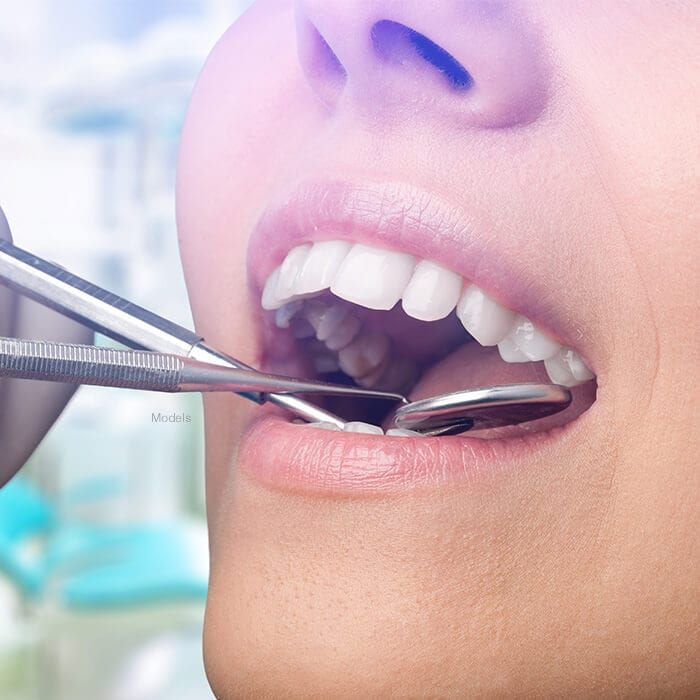Procedures Guide
Dr. Salamati is a periodontist who offers non-surgical and surgical treatments for tooth and gum restoration as well as cosmetic dentistry procedures.
Periodontal (Gum) Disease Dental Implants Dental Non-Surgical Procedures Dental Surgical ProceduresPeriodontal (Gum) Disease
Periodontal (gum) disease is characterized by different stages and levels of severity, from mild gingivitis to advanced periodontitis. These conditions develop when dental plaque is not removed from the teeth and left to form pockets between the gums and teeth that are prone to infection. While gum disease starts as inflammation in the gums, it can worsen to damage the teeth-supporting bone, resulting in tooth loss.
We offer periodontal disease and gingivitis treatment options that include deep cleaning (scaling and root planing), pocket reduction surgery (osseous surgery), regenerative procedures, and soft tissue grafts.

Gum Recession
Gum recession (gingival recession) occurs when the gum tissue pulls away from the tooth, leaving the tooth root exposed. This is often caused by periodontal disease; however, poor oral hygiene and heredity may also be what causes receding gums and can increase the rate at which gums recede. Gum recession treatments include gum graft surgery, which repairs the defect to prevent additional gum loss and promote further tooth and gum health. Gum graft surgery involves taking gum tissue from a donor source to cover the exposed root.

Oral Pathology and Oral Biopsy
An oral biopsy is used to screen for oral cancer and other mouth diseases. A biopsy requires the lab testing of abnormal tissue. During this biopsy, either a small piece of tissue or the entire abnormality is removed. This will depend on your circumstances. Once you receive the results of your biopsy, additional treatment can be determined, if necessary.
Dental Implants
Dental implants are artificial tooth roots secured to the jawbone that hold an artificial tooth or bridge. These “tooth implants” are appropriate for patients who have lost one tooth, several teeth, or all of their teeth. As the dental implant procedure requires adequate bone structure and strength, additional dental surgery may be necessary to improve bone quality.
Dental implants and their restorations should be treated and maintained like natural teeth.
Your dental implant cost will depend on different factors. During your consultation with Dr. Salamati, you will be provided with an exact cost of the procedure.

Replacing a Single Tooth
If you are missing a single tooth, a dental implant and crown can replace it. A dental implant replaces the tooth root, which better preserves the bone while providing long-lasting functional and aesthetic benefits.

Replacing Several Teeth
If you are missing several teeth, implant-supported bridges can replace teeth without support from the adjacent teeth. Implants for several teeth replace some of the tooth roots, which better preserves the bone.

Replacing All of Your Teeth
If you are missing all of your teeth, an implant-supported full bridge or full denture can replace them. Dental implants replace your lost teeth and some of the roots.

Teeth in a Day
Patients whose teeth are irreversibly damaged may consider teeth in a day, a specialized treatment that provides patients with a full set of teeth in a shorter amount of time (generally all in one day) than traditional implants. Teeth in a day are not appropriate for everyone and are often considered a last resort when no other treatment will suffice for teeth replacement.

Bone Graft/Ridge Augmentation
Bone graft, or ridge augmentation, is performed on patients with deformities (defects) in the upper or lower jaw whose bone is not strong enough to hold an implant. Dental bone grafting or ridge augmentation fills the spaces of inadequate bone with additional bone or bone substitute to build up the ridge and strengthen the jaw.

Sinus Augmentation
The sinus augmentation procedure improves the height, volume, and quality of bone near the sinuses by raising the sinus floor and allowing new bone formation. This deficiency is a result of natural anatomy in the area, periodontal disease, and/or missing teeth for a prolonged period of time. This “sinus lift” allows for the placement of dental implants near the sinuses.
Dental Non-Surgical Procedures
Dental health (both teeth and gums) should always be maintained and restored through the least invasive means possible. This often relies on non-surgical procedures, such as scaling and root planing, local delivery of antimicrobials, and systemic antibiotics.

Periodontal Disease Maintenance
Periodontal disease is the damage to the gums that occurs when bacterial infections develop in the gum and jawbones. Periodontal disease maintenance focuses on periodic teeth cleanings to prevent and control periodontitis (gum disease).

Periodontal Scaling and Root Planing
Periodontal scaling and root planing is a deep cleaning to remove plaque and tartar (dental calculus deposits) from periodontal pockets in order to eliminate bacterial toxins and smooth the tooth root. While some patients require additional therapy, such as system antibiotics or the local delivery or antimicrobials, others do not require further treatment to restore gum health.

Systemic Antibiotics
Systemic antibiotics are oral antibiotics that help fight bacteria and infection in the mouth. These antibiotics are often taken after deep cleanings such as scaling and root planing.

Local Delivery of Antimicrobials
Local delivery of antimicrobials is a treatment for periodontal disease that reduces or eliminates bacteria in the periodontal pockets.

Saving Natural Teeth
Saving natural teeth should always be the primary treatment approach. Many teeth can simply be treated with fillings, root canals, crown lengthening, and/or crowns instead of dental implants. Dental concerns should always be addressed in the least invasive means possible, and saving natural teeth is the priority.

Occlusal (Bite) Adjustment
Occlusal (bite) adjustment is a dental procedure performed to remove tiny interferences that prevent the biting surfaces of the teeth from coming together properly (malocclusion).

Oral Hygiene
Daily oral hygiene can keep your mouth healthy with at-home dental care between your visits with your dental hygienist. These dental hygiene practices promote overall oral health and help you avoid bad breath, bacterial plaque, tartar build-up, tooth decay, and tooth loss.
Dental Surgical Procedures
Non-surgical periodontal treatments are always the go-to options for periodontal health maintenance; however, non-surgical treatments have limits. When these options are insufficient, dental surgery with an experienced dental surgeon like Dr. Salamati may be considered to restore dental health.

Emergency Dentistry
Dental concerns and pain do not always wait for convenient times. A dental emergency is any situation where prompt and immediate treatment is required to preserve the tooth and its function or reduce the risk of a severe infection. Dental emergencies include tooth abscesses, tooth infections, trauma-induced tooth loss, pulpitis, and inflammation around the wisdom teeth or gums.

Gingival (Gum) Graft
Gingival (gum) graft surgery is often necessary to treat receding gums or can be used cosmetically to shorten long teeth. A gum graft uses a harvested piece of gum tissue from your palate or another donor area to cover the exposed roots, which protects them from further gum recession and decay, reduces sensitivity, and improves tooth stability. Gum graft surgery provides both functional and aesthetic benefits.

Pocket Reduction Surgery (Osseous Surgery)
Pocket reduction surgery (osseous surgery) is a periodontal treatment that halts the progression of gum disease. This gum surgery gives your periodontist access to the root surfaces of the teeth to remove tartar and minimize or eliminate the pockets in the alveolar bone.

Regenerative Procedures
Regenerative dental procedures stop the progression of gum disease by stimulating the natural growth of lost bone and tissue to support your teeth. This is achieved by folding back the gum tissue to remove bacteria before adding bone grafts, membranes, or tissue-stimulating proteins.

Crown Lengthening
The crown lengthening procedure improves the aesthetics of a gummy smile. A gummy smile occurs when your gums cover a larger tooth surface area than usual, making your teeth look shorter than they are. During a crown lengthening procedure, the excess gum tissue is reshaped to expose more of the natural tooth.
This procedure also allows you to save natural teeth that have severe decay.

Frenectomy (Frenum) Surgery
Frenectomy surgery removes labial or lingual aberrant soft tissue (frenulum) from the mouth to improve gum (gingival) health, prevent relapse of aligned teeth after orthodontic treatment, and eliminate tongue and lip tie.

Orthodontic Procedures
Orthodontic treatments involve an orthodontist applying devices like braces to adjust teeth or the underlying bone. Orthodontics can also correct crowded teeth and jaws or address underbites.

Fiberotomy
A dental fiberotomy is performed to detach the fibers that attach the tooth to the bone. This is done during orthodontic procedures to prevent the relapse of the teeth.

Tooth Extractions
You may need to have one or more teeth extracted if there is severe tooth decay, advanced periodontal disease, broken teeth, or wisdom teeth that cannot be saved any other way.

Cosmetic Dentistry
Cosmetic dental treatments like teeth whitening, veneers, gum reshaping, and braces can all improve the look of your smile.

IV Sedation and General Anesthesia
Dr. Salamati offers sedation dentistry (sleep dentistry) to meet your comfort needs when you visit his dental office. Sedative options for dental procedures include nitrous oxide sedation (laughing gas), oral sedation, conscious sedation, and general anesthesia.
